This post may contain affiliate links at no additional cost to you. As an Amazon Associate I earn from qualifying purchases. Click to view our full disclosure.
What's inside
Look in the mirror closely, and you may notice that one arm is bigger than the other.
Once you dive into a solid training regimen, the size and symmetry of your arms is a pretty common concern. You may suddenly see slight differences in muscular shape and size that you never did before.
I’ve heard this complaint many times in my 13 years as a trainer and therapist.
That’s why today, I will address why one arm is bigger than the other.
We’ll cover the causes, what can be done to improve it, recommended exercises, and pro tips to improve imbalance to bring symmetry to your physique.
Let’s jump in.
Why do I have one arm bigger than the other?

The main reason one arm is bigger is often due to it being the dominant side. This is a completely natural part of human anatomy.
Research identifies that dominant hands in sports, for example, can result in one side of the body being bigger than the other.
Is it normal to have one arm bigger than the other?
Related: Why Are My Arms So Skinny?
Yes, it is natural for one arm to be bigger than the other. The body is not as uniform as it’s represented in anatomical charts. Rather, we all have subtle differences in muscle shape, size, bony landmarks, and connective tissue.
Other factors such as prior injury, poor technique, load imbalances may play a role in development of muscle tissue.
However, the body intelligently adjusts to accommodate changes and optimize function.
Is it dangerous to have one arm bigger than the other?
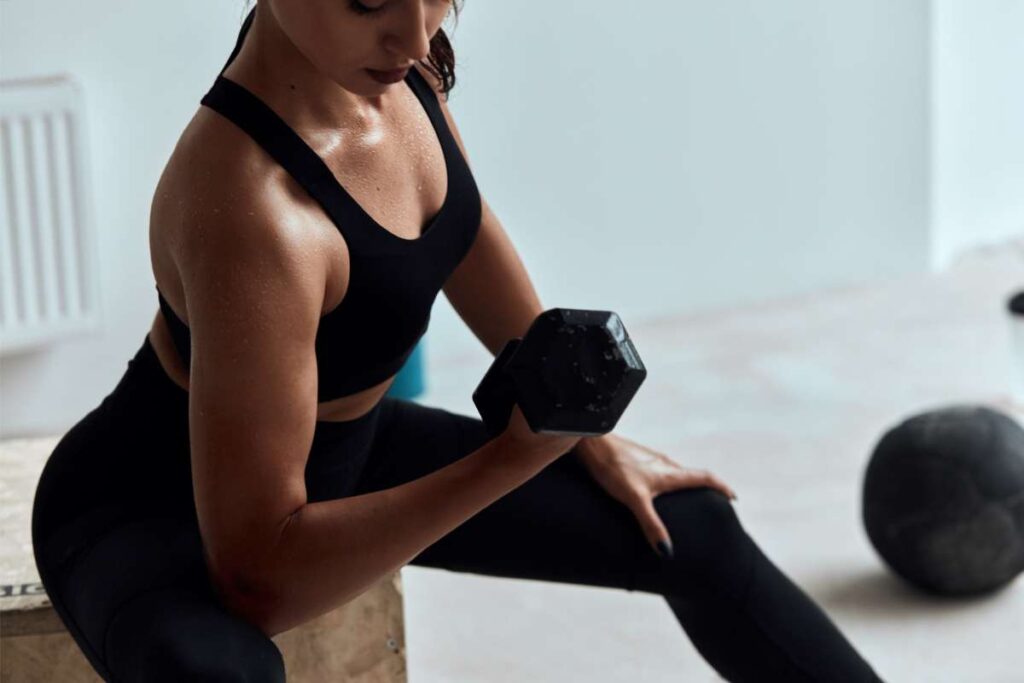
It is normal to have one arm bigger than the other. However, in some circumstances, having one arm bigger and stronger may lead to injury or poor function.
In fact, research suggests that asymmetry in arm strength as a result of sport may lead to injury.
One bigger arm due to a movement, such as throwing, may also result in a more dominant trunk, upper, and lower limbs to support that movement.
The result is potential injury due to overexertion of these fibers, while the opposite side is underutilized.
Those participating in sports such as handball, baseball, and other throwing sports should be mindful of these imbalances and carefully monitor them with resistance training.
Why do I have one arm bigger than the other? Six Reasons
Related: From Skinny Twig Arms to Rock Solid Biceps, Fast!
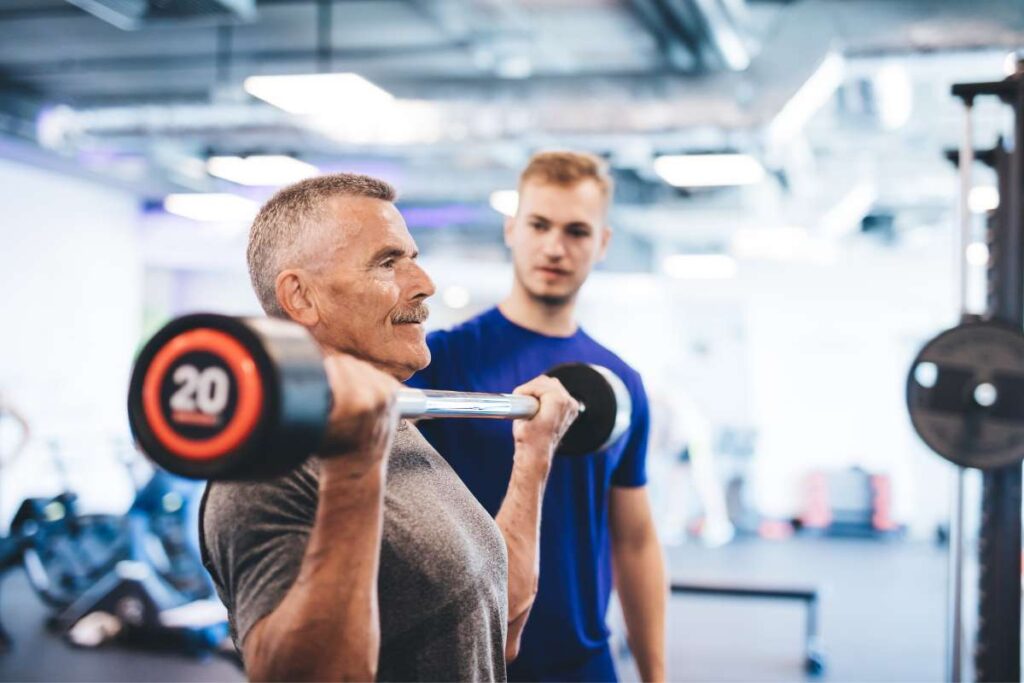
Having one arm skinnier than the other can be the result of many different factors, including prior injury, hand dominance, and training style.
Below is a list of the contributing factors, including recommendations to help you reduce the difference in arm sizes.
Genetics
Bicep genetics can play a big role in the size and shape of our arms.
Studies suggest that 30%-85% of muscle strength and 50%-80% of lean mass is hereditary.
This means that our muscle mass, the way it is formed, and the overall performance is somewhat down to our genetics.
While these figures have larger margins, there is no doubt that our muscles are formed based on strong genetic input.
Hand Dominance
Hand dominance is one of the biggest contributing factors to having one arm larger than the other.
When we continuously employ one arm, we create an external stimulus for the muscle or the arm that increases adaptations to muscle tissue.
Simple acts such as lifting objects, pushing, pulling, and turning door handles requires our muscles to be exerted, leading to strengthening and growth.
Over time, this will result in one arm becoming bigger than the other, and while not always immediately noticeable, can present a degree of asymmetry.
Loads Imbalance During Training
The way we load our body and perform our lifts in the gym can also play a role in one arm being bigger than the other.
When we lift in the gym, our dominant hand can push or pull with great levels of strength.
An example of this is the seated row. Traditionally, the seated row’s handles are attached, and when we row, we require both arms to pull simultaneously.
However, due to one arm being stronger we are pulling more of the weight with our dominant hand.
While this is not noticeable in the beginning of the set, during later reps the stronger, bigger arm may take over when you begin to fatigue.
If this is to happen on a regular basis, improvements to dominant hand performance may continue to widen the gap between the stronger and weaker arms.
Muscle Disuse Atrophy
Muscle disuse atrophy may be another reason you have one arm bigger than the other.
When we fail to use an arm or limb in any capacity, the body will begin to break down the muscle tissue.
Science illustrates that to have this happen, the body must have mechanical loading of the muscle.
When this happens, there are considerable decreases in muscle mass, strength, and physiological function.
This level of decreased mass has been seen in space flight, immobilization, and bed rest for significant periods of time.
Prior/Existing Injury
Prior or existing injuries can lead to one arm being larger than the other.
When we are nursing an injury, we tend to favor the other side of the body. This results in increased growth to that non-injured side.
That can turn into muscular imbalances once the injury has healed, especially if the joint of muscle has not been appropriately rehabilitated.
Research also notes that muscle tissue with prior injury or damage may also suffer from decreased strength.
While the injured arm may feel pain free, mechanically there may be lasting imbalances and weaknesses that can impair the muscle’s ability to function and activate correctly, hindering growth.
Incorrect Technique
When we approach the gym and perform our lifts, we can feel confident that our technique is on point. However, when viewed by others, our technique may be noticeably off.
This can be due to poor proprioception (our body’s awareness of itself in space), which can have us lifting with poor technique.
If left uncorrected, poor proprioception can potentially lead to muscles on one side being bigger than the other.
What To Do if You Have One Arm Bigger Than the Other
Related: Best Arm Workouts Without Weights For Guys
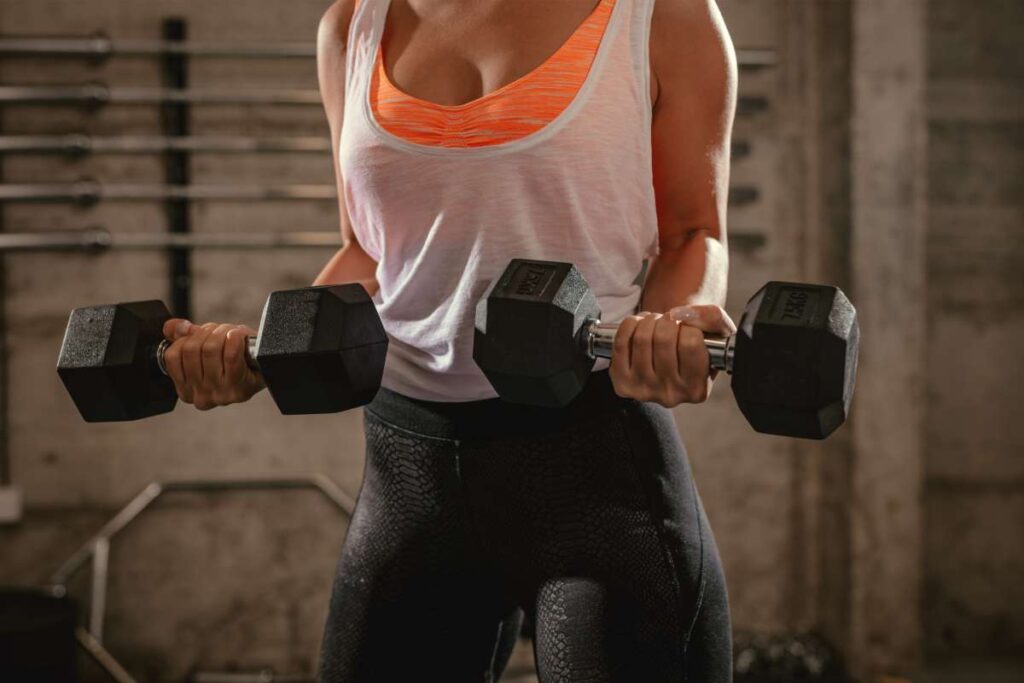
Now that we understand why you might have one arm bigger than the other, let’s go through how we can achieve symmetry in our arms.
Identify Common Training Mistakes
First, we need to identify the mistake or technique that may be leading to one arm being bigger than the other.
While it is natural to have one arm bigger, we should still consider that there may be imbalances to our mechanics or training.
Common mistakes can come in the form of technique and hand placement, as the weaker arm can tend to lag during your sets.
By doing this, you can then focus on correcting these mistakes and give our weaker side the best chance of contributing and increasing in mass.
Identify the Small Muscle
When we train to improve arm symmetry, it is important to identify the exact muscle of the arm that is smaller.
While it is easy to increase training volume for the entire arm it is more beneficial to identify the exact muscle. This will help you link it to potential exercises, common mistakes, and lack of muscular contraction during those exercises.
From here, you can again focus on improving technique and activation of those fibers.
Lift Using Independent Handles
A great way to ensure each arm is performing during your lifts is to complete exercises with independent handles.
Many exercises in the gym that require machines, barbells, and cables tend to have one point of resistance, meaning that both hands pull on the same handle.
When this happens, our dominant hand can pick up the slack and lift more during the course of the sets. While this may not always be noticeable, it can increase muscle mass of your dominant arm.
Perform Unilateral Exercises
Performing unilateral exercises can improve muscle activation and increase focus to your weaker muscles.
Single-arm variations for dumbbell preacher curls, dumbbell bicep curls, cable tricep extensions, and dumbbell tricep extensions will allow you to focus on lifting and contracting the target muscles.
This lets your weaker arm perform the lifts without the dominant side taking over.
Increase Training Volume
Increasing training volume is logically beneficial in increasing muscle mass.
Studies indicate that performing additional sessions will aid in greater hypertrophy.
This does not mean that we should neglect our single-arm training, but rather, supplement our arm training with additional sets throughout the week.
By undertaking this method, we can hope to increase the stimulus to the muscles of our arms and improve activation of our weaker muscles.
Exercises To Do if You Have One Arm Bigger Than the Other
Having one arm bigger than the other is natural, but if you’re looking to increase mass and symmetry, here are nine exercises to help you even things out.
1. Single-Arm Preacher Curl
Single-arm preacher curls are great exercise for targeting the biceps one at a time. This will allow you to focus on performing quality contractions with your less-dominant arm.
Equipment Requirements
- Incline Bench
- Dumbbell
How To Perform the Single-Arm Preacher Curl
- Stand behind an incline bench set at 70 degrees.
- Holding a dumbbell, place your tricep on the bench with your elbow extended at 160 degrees.
- Begin by curling the dumbbell up toward your shoulder.
- Curl until your elbow is flexed at 30 degrees.
- Lower back down to the starting position. Repeat.
Benefits
- Great for isolating biceps
- Can focus on quality of movement with every rep
Pro Tips
- When performing your curls, focus on contracting the bicep through the full range of motion. This will improve your mind-muscle connection.
- When lowering the dumbbell, only lower until 160 degrees. This will reduce the tension put on the bicep tendon and reduce the chance of injury.
2. Dumbbell Concentration Curl
The dumbbell concentration curl is a simple and effective way to isolate the bicep with nothing more than a dumbbell.
Equipment Requirements
- Bench
- Dumbbell
How To Perform the Dumbbell Concentration Curl
- Sit down on the side of the bench, lean forward, and pick up the dumbbell.
- With the dumbbell arm, place the lower part of your tricep against your inner thigh.
- Allow your elbow to extend at 160 degrees.
- Begin by curling the dumbbell up toward your shoulder until your elbow is flexed at 30 degrees.
- Once you reach this position, lower the dumbbell back down to the starting position.
- Once you have completed your set, switch arms and repeat.
Benefits
- Placing your tricep against the inner thigh mimics a preacher curl set up
- Increase muscle mass
Pro Tips
- Start with a lighter weight and focus on contracting the bicep with each rep.
- Concentrate on breathing, inhaling as you lower the dumbbell and exhaling as you curl.
3. Dumbbell Cross-Body Curl
The dumbbell cross-body curl is a brilliant exercise for increasing muscle mass of the biceps and forearms.
Performing the curls in an alternating fashion allows you to focus on the target muscles with each rep.
Equipment Requirements
- Dumbbells
How To Perform the Dumbbell Cross-Body Curl
- Stand holding a dumbbell in each hand with a neutral grip.
- Start by curling the dumbbells toward the midline of the body.
- Curl until your elbows are bent at 40 degrees, then lower back down until your arm is straight.
- Alternate arms for the duration of the set.
Benefits
- Targets biceps and forearms
- Using dumbbells requires each arm to lift their own weight
Pro Tips
- Begin with a lighter weight and focus on technique and getting the correct contraction.
- To improve stability through the body, have knees unlocked and with each rep, exhale and contract the core.
4. Bayesian Curl
Bayesian curls are great for targeting each bicep individually, as each arm will have their own cable.
This will be great to build up your smaller arm and stop the dominant arm from taking over.
Equipment Requirements
- Cable machine
How To the Perform Bayesian Curl
- Set the cable pulley to the lower point.
- Stand in the middle of the machine, facing away.
- Grab a handle in each hand and take a step forward so that you take the weight of the cables.
- Begin by curling the handles up toward your shoulders until your elbows are bent at 40 degrees.
- Once at the top, gradually lower them back down to the starting position. Repeat.
Benefits
- Great for building symmetry
- Adjustable pulleys help you get the right set up for the best activation
Pro Tips
- When lowering the cables, do so gradually and with control. This will help improve activation of the biceps and eccentrically load the muscle for greater growth.
- When setting up in the split stance, do so a step away from the machine. This will improve your ability to control the cables and improve your ability to squeeze the muscle each rep.
5. Dumbbell Hammer Curls
Dumbbell hammer curls are designed to target the upper arm and forearm.
By performing them with dumbbells, each arm will be responsible for lifting their own weight, which is great for developing symmetry.
Equipment Requirements
- Dumbbells
How To Perform Dumbbell Hammer Curls
- Standing upright, pick up a dumbbell in each hand and hold them with a neutral grip.
- Start by curling the dumbbells up toward your shoulders while your elbows remain tucked to your sides.
- Curl until your elbow is flexed at 30 degrees.
- Lower back down to the starting position and repeat.
Benefits
- Targets forearms and upper arm
- Improve physique
Pro Tips
- When performing your curls, exhale and tense the core. This will reduce movement of the body and allow for greater focus on squeezing the biceps.
- Concentrate on the quality of the contraction, especially for your weaker arm.
6. Dumbbell Tricep Kickback
The dumbbell tricep kickback is a great exercise for isolating the triceps and allowing you to focus on activation and contraction.
Equipment Requirements
- Dumbbell
- Bench
How To Perform the Dumbbell Tricep Kickback
- Place one knee onto the bench.
- Lean forward and support yourself with the same-side hand, keeping your torso parallel with the floor.
- Pick up a dumbbell with your free hand.
- Row it up to the side of your body so your elbow is bent at 90 degrees.
- Begin by extending your elbow so your forearm is parallel to the floor.
- Then lower the dumbbell back down until your elbow is bent at 90 degrees.
- Repeat for the remaining reps and then switch sides.
Benefits
- Great for targeting triceps
- Unilateral exercises that is great for building symmetry
Pro Tips
- Keep your elbow tucked to the side and engage your lat. This will help improve your ability to isolate the tricep with each rep.
- Start with a lighter weight as the kickback does not need a lot of weight to be effective.
7. Cable Tricep Kickback
The cable tricep kickback is excellent for targeting the triceps as the pulley system allows you to adjust the cable to match your needs.
The cable system also provides you with a constant resistance which is great for activating your triceps through the full range of motion.
Equipment Requirements
- Cable machine
How To Perform Cable Tricep Kickbacks
- Set the cable pulley to just above waist height with no handle attached.
- Stand in front of the cable and grasp it with one hand just above the ball.
- Lean forward at the hips and place your free hand against the rails for support.
- Row your arm back so that your upper arm is in line with your torso and your elbow is bent at 90 degrees.
- Begin by extending your elbow until your forearm is in line with your torso.
- Once you have done this gently release until your elbows are bent at 90 degrees.
- Complete all reps for this side then switch to the other hand.
Benefits
- Cables provide continuous resistance which is great for targeting triceps
- Increases muscle mass
Pro Tips
- Begin with a lighter resistance and focus on squeezing the tricep. Cables are excellent at activating target muscles and only need a small amount of weight to be effective.
- Focus on keeping the spine neutral and elbows tucked to your side for the duration of the set. This will improve your ability to contract the tricep.
8. Cable Tricep Extension
The cable tricep extension is a brilliant exercise for targeting the triceps, with the cables again providing a continuous resistance that allows you to target all three heads of the muscle.
Equipment Requirements
- Cable machine
- Rope extension
How To Perform Cable Tricep Extensions
- Adjust the cable pulley to the highest point and attach a rope handle.
- Grab the rope with one hand and tuck your elbow to your side at the hip.
- Begin by extending your elbow until your arm is straight.
- Gently release back to the beginning position.
- Complete all reps for this side and switch.
Benefits
- Allows you to independently concentrate on each arm’s strength and performance
- Cable allows you to adjust to your height, which can help improve contraction
Pro Tips
- Keep your elbow tucked to the side for the duration of the set. This will help isolate the fibers of the tricep.
- Exhale and engage core with each rep. This will improve stability.
9. Dumbbell Standing Tricep Extension
The standing dumbbell tricep extension is a simple and effective exercise that allows you to work the triceps with nothing more than a dumbbell.
By performing the exercise one arm at a time, you can concentrate on targeting the tricep with every rep.
Equipment Requirements
- Dumbbell
How To Perform Dumbbell Tricep Extensions
- Stand with a dumbbell in one hand.
- Lift the dumbbell directly overhead with a pronated grip.
- Keep the upper arm vertical, allow your elbow to bend, and slowly lower the dumbbell behind your head.
- Lower until your elbow is bent at 90 degrees.
- Lift the dumbbell back up until the entire arm is completely straight.
- Complete all reps for this set and then switch sides.
Benefits
- Requires only a dumbbell to improve muscle mass
- Improves physique
Pro Tips
- Start with a lighter weight, as keeping the upper arm vertical can be challenging. Going too heavy, too soon can result in arching of the back and poor tricep activation.
- Aiming to keep your upper arm vertical will improve your ability to target the triceps.
Pro Tips To Fix an Arm Imbalance Safely
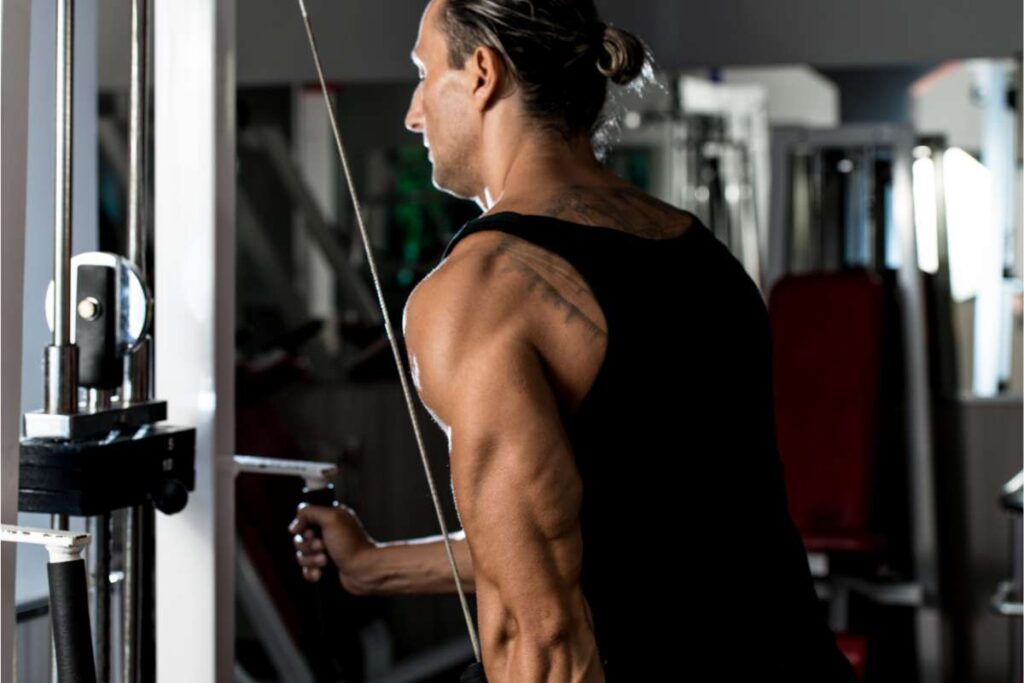
When we discover that one arm is bigger than the other, we can feel like a bull at a gate ready to just smash out more arm work.
However, this may not be the best approach as failing to have a plan is surely a plan to fail.
To ensure we are taking steps in the right direction, here are some pro tips to fix your arm imbalances safety.
Take Your Time
First and foremost, you need to set realistic expectations and take your time.
As previously mentioned, when we notice our arms are different sizes, we want to solve the problem quickly.
However, this is something that will take time.
When you take your time you can manage your expectations, allow yourself to slow down, and focus on making small progress.
This will help you build up your weaker arm over time for lasting results.
Focus on Muscle Contraction
Focusing on muscle contraction is a key component of building up your less dominant side.
When we focus on contracting our target muscles, we improve our mind muscle connection, which research has identified to help improve activation of fibers and promote muscle growth.
Increase Protein Intake
Increasing your protein intake can help be a great way to build muscle and aid in recovery.
Studies recommend consuming 1.6g-2.2g of protein per kilogram of body for muscle growth. This can be consumed through food as well as supplementation like protein shakes or protein bars.
While this isn’t a magic trick that will bring symmetry to your arms, it can contribute to building your smaller arm.
Increase Calorie Intake
Increasing your calorie intake can go a long way to helping you build muscle.
Research suggests that consuming a calorie surplus can is required for muscle hypertrophy.
Currently, studies recommend a caloric intake of 2,500 for men and 2,000 for women. Those numbers are just for maintenance, though.
To increase mass, we recommend a surplus of 500 calories through the consumption of nutrient and protein dense-foods.
If you would like the right number for your current stats and lifestyle, try this calorie calculator.
This will provide you with an accurate calorie intake based on age, gender, height, weight, and activity level.
Once you have your exact calorie target, consider using a nutrition tracker like MyFitnessPal. This will help you track your meals and make adjustments to your calories if needed.
Final Thoughts
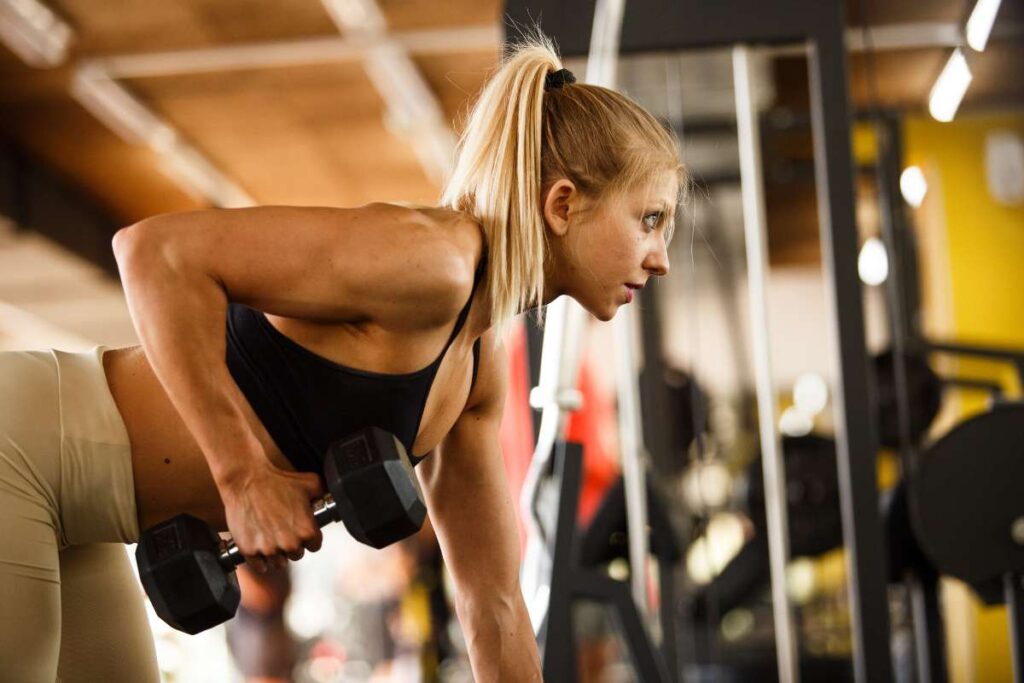
Having one arm bigger than the other is a natural part of human anatomy.
While factors such as prior injury, poor technique, hand dominance play a big role, these can be worked around to increase the size of the weaker arm and improve symmetry.
So, if you are setting out to build a more even physique, identify the muscles that are smaller, correct common training mistakes, and take your time performing single-arm lifts, focusing on contraction.
This will help you build a better connection with your body, and improve your results.
Have you noticed that one arm is bigger than the other? What factors do you think are contributing to the size difference?
Let us know in the comments.
Is it normal for one arm to be stronger than the other?
Yes, it is normal to have one arm bigger than the other as we typically have a dominant hand. This can also be seen around the body with increased muscle and asymmetry favoring the preferred side.
How do you fix uneven arm size?
To fix uneven arm size you should identify the area that is lagging and find out the cause. If it is due to injury, muscular imbalances should be addressed with corrective exercises.
However, if it is simply due dominance, focus on performing the correct exercises to target weaker sides’ muscle fiber.
Increasing training volume while using correct technique and paying attention to muscle contraction. This will help you improve symmetry of the arms.
Will muscle imbalance fix itself?
No, muscle imbalances won’t fix themselves. While not all imbalances need to be addressed, if they result in pain or dysfunction that is affecting your daily life, they should be treated with corrective exercise.
If muscle imbalances go untreated, they can create further dysfunction, lower quality of movement, or greater injuries in the future.
Why is my dominant arm smaller than the other?
Variations in muscle mass or body fat percentage determine overall size of the arm. Having a dominant arm doesn’t always mean that it is the strongest. It means that it performs the most.
For many professions that require manual labor, the off-hand tends to hold and support large objects.
Meanwhile the dominant hand performs a variety of fine motor movements and lifting tasks.
This can mean the less-dominant side can have a greater mass due to increased stimulus.
The other rationale here is that a dominant hand would have greater muscle mass and less body fat, meaning that it would be smaller overall.
What causes arm imbalance?
Arm imbalances can be caused by prior or current injury or poor technique during daily tasks. When we move, we do so in the most efficient way possible, but this isn’t always optimal.
Over time, this can result in imbalances, with the preferred arm’s muscle mass building up in areas that are constantly stimulated.
How long does it take to fix muscle imbalance?
Three to six months, depending on the degree of muscle imbalances and the consistency with which the corrective exercises are performed.
Why is one of my arms skinnier than the other?
One arm being skinnier than the other can be due to one side being more dominant, injury, poor training technique, or genetics.

